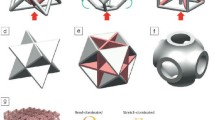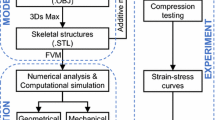Abstract
The present contribution describes an optimization-based design technique of elastic isotropic periodic microarchitectures with crystal symmetries aiming at the realization of composites with extreme properties. To achieve this goal, three consecutive procedures are followed: (i) a series of inverse homogenization problems with symmetry constraints, (ii) a correlation analysis between symmetries and effective elastic properties of the attained microarchitectures, and (iii) the pattern resemblance recognition of these topologies and their redesign, by adopting microstructures with two length-scales, through optimized parametric geometries. This paper is devoted to assessing the third procedure because the first two procedures have been evaluated in previous works of the authors, and here they are only summarized. By applying the methodology, two plane group symmetries are assessed to define two families of 2D periodic parameterized microarchitecture. Once the parameters have been optimized, the resulting composites achieve elastic isotropic properties close to the whole range of the theoretically estimated bounds. Particularly, an unprecedented microstructure attaining the theoretical maximum stiffness is reported. Starting from these parameterized topologies, simple, one-length scale, and easily manufacturable geometries are defined. One of the so-designed microarchitectures has been manufactured and tested, displaying an effective Poisson’s ratio of − 0.90 simultaneously with a high shear modulus.









Similar content being viewed by others
Replication of results
The homemade codes, including the inverse homogenization of Section 3, the geometrical description of the parameterized microstructures with conformal meshes of Section 4, and the multi-objective optimization using a genetic algorithm of Section 5, have been implemented in Matlab. Numerical data characterizing the presented results, for instance, material properties of the phases, and optimal parameters are displayed in the paper. The full set of numerical and experimental data, as well as the codes, are freely available under request.
Data availability
A video showing the transition of the microstructures attained along the four Pareto fronts, and a .csv file describing the values of the parameters and properties of all the microstructures lying on the Pareto fronts, can be found in the open-source online data repository hosted at Mendeley Data (Rossi et al. 2020a).
Code availability
The homemade code is written in Matlab and is freely available under request.
Notes
It is worth remarking that void is needed as the soft phase to achieve null eigenvalues of the constitutive tensor, achieving strict bimode materials.
It is commonly observed that solutions of the inverse homogenization problem, in step 1 of item (i) may provide microarchitectures with higher symmetry to the imposed one. In these cases, the procedure in item (iii) adopts this higher symmetry.
Note that orthogonality of the laminate axis and the stiff material on the interphase is lost when d is increased once laminate with γ3 vanishes.
References
Amstutz S (2011) Connections between topological sensitivity analysis and material interpolation schemes in topology optimization. Struct Multidiscip Optim 43(6):755–765
Amstutz S, Andrä H (2006) A new algorithm for topology optimization using a level-set method. J Comput Phys 216(2):573–588
Amstutz S, Giusti S, Novotny A, de Souza Neto E (2010) Topological derivative for multi-scale linear elasticity models applied to the synthesis of microstructures. Int J Numer Methods Eng 84(6):733–756
Babaee S, Shim J, Weaver JC, Chen ER, Patel N, Bertoldi K (2013) 3d soft metamaterials with negative poisson’s ratio. Adv Mater 25(36):5044–5049. https://doi.org/10.1002/adma.201301986
Blanco PJ, Sánchez PJ, de Souza Neto EA, Feijóo RA (2016) Variational foundations and generalized unified theory of rve-based multiscale models. Archiv Comput Methods Eng 23(2):191–253
Bückmann T, Schittny R, Thiel M, Kadic M, Milton GW, Wegener M (2014) On three-dimensional dilational elastic metamaterials. New J Phys 16(3):033032. https://doi.org/10.1088/1367-2630/16/3/033032
Cheng Y, Yang F, Xu J, Liu X (2008) A multilayer structured acoustic cloak with homogeneous isotropic materials. Appl Phys Lett 92(15):151913
Cherkaev A, Gibiansky L (1993) Coupled estimates for the bulk and shear moduli of a two-dimensional isotropic elastic composite. J Mech Phys Solids 41(5):937–980. https://doi.org/10.1016/0022-5096(93)90006-2
Deb K, Pratap A, Agarwal S, Meyarivan T (2002) A fast and elitist multiobjective genetic algorithm: Nsga-ii. IEEE Trans Evol Comput 6(2):182–197. https://doi.org/10.1109/4235.996017
Francfort GA, Murat F (1986) Homogenization and optimal bounds in linear elasticity. Arch Ration Mech Anal 94(4):307–334. https://doi.org/10.1007/bf00280908
Frenzel T, Kadic M, Wegener M (2017) Three-dimensional mechanical metamaterials with a twist. Science 358(6366):1072–1074. https://doi.org/10.1126/science.aao4640
Frenzel T, Köpfler J, Jung E, Kadic M, Wegener M (2019) Ultrasound experiments on acoustical activity in chiral mechanical metamaterials. Nat Commun 10(1):1–6. https://doi.org/10.1038/s41467-019-11366-8
Giusti SM, Mróz Z, Novotny A (2017) Sokołowski J. Topology design of thermomechanical actuators. Structural and Multidisciplinary Optimization 55(5):1575–1587
Hashin Z (1962) The elastic moduli of heterogeneous materials. J Appl Mech 29(1):143–150. https://doi.org/10.1115/1.3636446
Hashin Z (1965) On elastic behaviour of fibre reinforced materials of arbitrary transverse phase geometry. J Mechan Phys Solids 13(3):119–134
Hashin Z, Shtrikman S (1963) A variational approach to the theory of the elastic behaviour of multiphase materials. J Mech Phys Solids 11(2):127–140. https://doi.org/10.1016/0022-5096(63)90060-7
Imediegwu C, Murphy R, Hewson R, Santer M (2019) Multiscale structural optimization towards three-dimensional printable structures. Struct Multidiscip Optim 60(2):513–525
Kadic M, Milton GW, van Hecke M, Wegener M (2019) 3d metamaterials. Nat Rev Phys 1(3):198–210. https://doi.org/10.1038/s42254-018-0018-y
Layman C, Naify C, Martin T, Calvo D, Orris G (2013) Highly anisotropic elements for acoustic pentamode applications. Phys Rev Lett 111(2):024302
Liu J, Gaynor AT, Chen S, Kang Z, Suresh K, Takezawa A, Li L, Kato J, Tang J, Wang C et al (2018) Current and future trends in topology optimization for additive manufacturing. Struct Multidiscip Optim 57(6):2457–2483
Méndez C, Podestá J, Lloberas-Valls O, Toro S, Huespe A, Oliver J (2017) Computational material design for acoustic cloaking. Int J Numer Methods Eng 112(10):1353–1380
Méndez C, Podestá J, Toro S, Huespe A, Oliver J (2019) Making use of symmetries in the three-dimensional elastic inverse homogenization problem. Int J Multiscale Comput Eng 17:261–280. https://doi.org/10.1615/IntJMultCompEng.2019029111
Milton G (1986) Modelling the properties of composites by laminates. In: Homogenization and effective moduli of materials and media. Springer, pp 150–174, https://doi.org/10.1007/978-1-4613-8646-9_7
Milton G (2020a) Planar polycrystals with extremal bulk and shear moduli. arXiv:200208788
Milton G, Cherkaev A (1995) Which elasticity tensors are realizable?. J Eng Mater Technol 117(4):483–493
Milton G, Briane M, Harutyunyan D (2017) On the possible effective elasticity tensors of 2-dimensional and 3-dimensional printed materials. Math Mech Complex Syst 5(1):41–94. https://doi.org/10.2140/memocs.2017.5.41
Milton GW (2020b) Some open problems in the theory of composites. arXiv:200803394
Ni X, Guo X, Li J, Huang Y, Zhang Y, Rogers JA (2019) 2d mechanical metamaterials with widely tunable unusual modes of thermal expansion. Adv Mater 31(48):1905405. https://doi.org/10.1002/adma.201905405
Norris A (1985) A differential scheme for the effective moduli of composites. Mech Mater 4 (1):1–16. https://doi.org/10.1016/0167-6636(85)90002-X
Norris A (2008) Acoustic cloaking theory. In: Proceedings of the royal society of london A: Mathematical, physical and engineering sciences, vol 464, pp 2411–2434
Novotny A, Sokołowski J (2013) Topological derivatives in shape optimization. Interaction of mechanics and mathematics. Springer Science & Business Media, Berlin
Osanov M, Guest J (2016) Topology optimization for architected materials design. Annu Rev Mater Sci 46:211–233
Ostanin I, Ovchinnikov G, Tozoni D, Zorin D (2018) A parametric class of composites with a large achievable range of effective elastic properties. J Mech Phys Solids 118:204–217. https://doi.org/10.1016/j.jmps.2018.05.018
Podestá J, Méndez C, Toro S, Huespe A (2019) Symmetry considerations for topology design in the elastic inverse homogenization problem. J Mech Phys Solids 128:54–78. https://doi.org/10.1016/j.jmps.2019.03.018
Rossi N, Podestá J, Bre F, Méndez C, Huespe A (2020a) Dataset of parameterized isotropic microstructures attaining extreme properties. Mendeley Data, v1 https://doi.org/10.17632/hcpvmnwm4p1
Rossi N, Yera R, Méndez C, Toro S, Huespe A (2020b) Numerical technique for the 3d microarchitecture design of elastic composites inspired by crystal symmetries. Comput Methods Appl Mech Eng 359:112760. https://doi.org/10.1016/j.cma.2019.112760
Rupin M, Roux P, Lerosey G, Lemoult F (2015) Symmetry issues in the hybridization of multi-mode waves with resonators: an example with lamb waves metamaterial. Sci Rep 5:13714. https://doi.org/10.1038/srep13714
Sigmund O (1994) Materials with prescribed constitutive parameters: an inverse homogenization problem. Int J Solids Struct 31(17):2313–2329. https://doi.org/10.1016/0020-7683(94)90154-6
Sigmund O (2000) A new class of extremal composites. J Mech Phys Solids 48(2):397–428. https://doi.org/10.1016/S0022-5096(99)00034-4
Sigmund O, Maute K (2013) Topology optimization approaches. Struct Multidiscip Optim 48 (6):1031–1055
Vigdergauz S (1999) Energy-minimizing inclusions in a planar elastic structure with macroisotropy. Struct Optim 17(2-3):104–112. https://doi.org/10.1007/BF01195935
Wang Y, Sigmund O (2020) Quasiperiodic mechanical metamaterials with extreme isotropic stiffness. Extreme Mechanics Letters 100596:34. https://doi.org/10.1016/j.eml.2019.100596
Wu Z, Zheng Y (2017) Moiré chiral metamaterials. Adv Opt Mater 5(16):1700034. https://doi.org/10.1002/adom.201700034
Xia L, Breitkopf P (2015) Design of materials using topology optimization and energy-based homogenization approach in matlab. Struct Multidiscip Optim 52(6):1229–1241
Yera R, Rossi N, Méndez C, Huespe A (2020) Topology design of 2d and 3d elastic material microarchitectures with crystal symmetries displaying isotropic properties close to their theoretical limits. Appl Mater Today 18:100456. https://doi.org/10.1016/j.apmt.2019.100456
Zong H, Zhang H, Wang Y, Wang MY, Fuh JY (2018) On two-step design of microstructure with desired poisson’s ratio for am. Materials & Design 159:90–102
Acknowledgments
The authors are grateful to Juan Marcos Banegas and Javier Andrés Acosta of CIESE-UTN FRSF for their help with the experimental study.
Funding
CONICET and ANPCyT - Argentina (grants PICT 2016-2673).
Author information
Authors and Affiliations
Corresponding author
Ethics declarations
Conflict of interest
The authors declare that they have no conflict of interest.
Additional information
Responsible Editor: Zhen Luo
Publisher’s note
Springer Nature remains neutral with regard to jurisdictional claims in published maps and institutional affiliations.
Electronic supplementary material
Appendix. Equations used in the multi-objective optimization problems
Appendix. Equations used in the multi-objective optimization problems
In the mathematical formulation of the multi-objective problem (10), the volume fraction constraints are written as follows.
In the case of p31m microstructure, replacing (11) into (10):
where:
The angles β1 and β2 depend on α and are calculated from the following expressions:
In the case of the p3m1, by replacing (12) into (10):
where γ1, γ2, γ3, and \({f_{1}^{t}}\) are parameters defined in Fig. 5 and:
The d parameter may increase beyond the vanishing of the γ3 laminate region (see for example microstructures P4 and P5 in Fig. 7). In this situation, the relation between the parameters to respect a given volume fraction comes from:
where:
Rights and permissions
About this article
Cite this article
Rossi, N., Podestá, J.M., Bre, F. et al. A microarchitecture design methodology to achieve extreme isotropic elastic properties of composites based on crystal symmetries. Struct Multidisc Optim 63, 2459–2472 (2021). https://doi.org/10.1007/s00158-020-02823-w
Received:
Revised:
Accepted:
Published:
Issue Date:
DOI: https://doi.org/10.1007/s00158-020-02823-w




